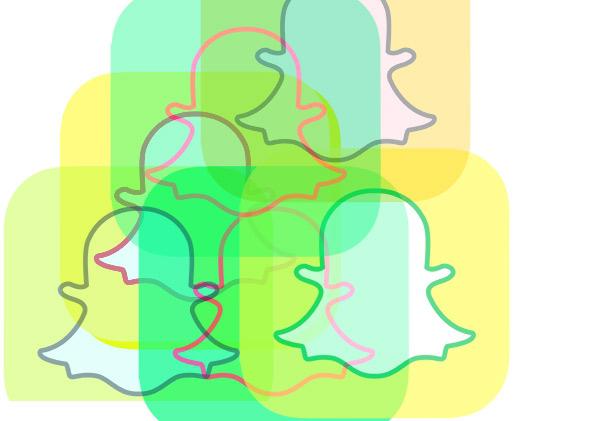The only person who ever Snapchats me is Snapchat. I downloaded America’s fastest-growing social app—beloved by teens, not understood by olds, of which I am hereby establishing myself as one—over a year ago. I used it briefly, became disillusioned with my coloring skills, and then relegated it to a little folder on my phone, where messages piled up from no one but Snapchat, gamely trying to entice me to give it another try. I ignored these robo-chats for months, until a few weeks ago, when Snapchat launched a dozen “channels”—a dog whistle to a TV critic like me—on which 11 other media companies, including People, the Food Network, Vice, and Comedy Central, would provide content to Snapchat’s growing user base every 24 hours.
As used by Snapchat, the term channel is both misleading and apt. Unlike on television or YouTube, the material available is only sporadically video. Rather, the content is whatever the media company in question is already churning out, with a skew toward a younger audience: The Food Network, for example, provided a recipe for how to cook scrambled eggs. Comedy Central’s channel features clips from its television shows. ESPN’s channel consists of both highlight-reel videos and news stories. The Daily Mail channel offers up about a dozen text- and photo-based stories also available on the Daily Mail’s website. People recently provided a Pretty Little Liars recap.
The only change most of these stories undergo as they move from the Internet to Snapchat is a bit of repackaging, in the form of a snazzy, replaying introduction page, often animated and usually accompanied by music. The introduction, in other words, looks a lot like a Vine. If you imagine a rotating headline box used by websites such as this, populated by quick Vine-like videos, all on your phone—that’s basically what a Snapchat channel looks like. (Unlike many other Snapchat features, the channels are very easy to use. They are not, however, so easy to find. My advice on this is: Locate the hamburger.) “OMG You Won’t Believe Who Got Engaged,” flashed a recent Cosmo intro, and users could either swipe left to dismiss and move on to “The Hottest DILFS,” or swipe down to read about Lady Gaga’s recent engagement. (The Vine-then-swipe-for-story format introduces the element of surprise: On Cosmo’s website, the Lady Gaga story was headlined “Lady Gaga, Taylor Kinney engaged.”)
Snapchat’s partners’ heterodox interpretation of what belongs on a channel is the best thing about them. The worst kind of Snapchat channel, to my mind, is the one that closely resembles a TV station: The Warner Music Group daily puts up five new music videos from its new artists like some MTV throwback, and I never wanted to watch any of them. Yahoo deploys Katie Couric to introduce each news story, and the old-school news anchor act, even in the service of something as newfangled as Snapchat, just is not as clickable as a Food Network story about bedding that looks like pizza, a National Geographic photo essay about “colossal sea creatures,” or the “story behind Kimye’s wolf eyes.”
Almost without exception, the only content that is entirely native to Snapchat is so short and simple you can’t even swipe through it for more. (The exception here is Snapchat’s own channel, which, for now, is more committed to creating dynamic content that lives only on Snapchat than its partners are.) Cosmo provides a quote of the day. National Geographic asks a trivia question. Both CNN and ESPN wished Michael Jordan a happy birthday, using the same quote. CNN also recently followed a text story about “Religion’s Week From Hell” and a video about “Why Politicians Try to Speak Spanish” (introduced by a clip of Hillary Clinton saying “Sí, se puede”) with a Snapchat-only slide that consisted exclusively of the following information: “Everyone Wants a Piece of Yeezus. Kanye West’s just released sneaker for Adidas, the $350 Yeezy Boost, has already sold out. On Ebay, the kicks sell in excess of $1000 a pair.”
If this sounds nothing at all like a “channel” to you, and just another way for Snapchat and its partners to make money while giving teens a way to waste time—well, that is, in fact, exactly the way in which Snapchat channels feel like television. Channel surfing, in which you plop down on the couch, pick up the remote, and make your way through your particular stations of the cross (TBS-TNT-FX-TCM-AMC-Bravo-E!-VH1-MTV-etc.-etc., or whatever your personal catechism), letting the TV offerings wash over you, is not as popular as it once was. DVRs, streaming television services, and cord-cutting have made it much more common to turn the television or computer on with a certain kind of intentionality, a will to watch something in particular.
But Snapchat channels are a throwback to the couch potato mode of passive consumption. Every day, Cosmo and CNN and their ilk have selected five or so stories for you to flip through, read, watch, or skip. The content may also be available on the Web, but consuming it here is even easier: You don’t have to search for anything, click on anything, seek out anything. It has already been picked out for you. Everywhere you and your phone are has become the proverbial couch.
After a couple of days using the channels, you will know to skip Warner Music Group like it is QVC and maybe even be excited for what Vice and National Geographic want to show you (maybe another video about the magic of fountain pens!). You may be “reading” instead of “watching,” but your phone has become exactly like a remote control, an electronic device providing you with maximal entertainment for minimal effort. Snapchat channels may be in their infancy, but they have already learned one of TV’s great lessons: Whatever is on is better than nothing.
